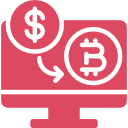Reviews are inherently subjective. Sometimes people leave poor reviews because they get scammed, and this may not be the website’s fault. Be sure to always secure your account regardless of where you keep your money. Personally, we use our own experiences to create a balanced review of any exchange based on its security, trading volume and fee scale.
1 – Exchanges Safety
 When you deposit your hard-earned money, safety should be your top concern. Luckily, exchanges usually have precautions to safeguard you from dishonest folk. Read other people’s opinions on the website; after all, they have taken the plunge before you, so that’s free information.
When you deposit your hard-earned money, safety should be your top concern. Luckily, exchanges usually have precautions to safeguard you from dishonest folk. Read other people’s opinions on the website; after all, they have taken the plunge before you, so that’s free information.
Browse social media, blogs, and forums to get the complete picture. Also, don’t get frustrated when the exchange needs to verify your identity in a series of questions and document submission. This is for consumer protection. If a site doesn’t have stringent standards, be skeptical of the entire process. Finally, see how long the marketplace has been in operation. Long-standing exchanges are more trustworthy.
2 – Interface & High-Frequency Trading
A good user interface (UI) can make or break an exchange. Having the best graphs, most up-to-date prices and a clean look at your current funds are quality of life assurances that every trader expects. This essential information will certainly affect decisions made by traders, so a more developed interface with easy-to-use selections will win out over sloppy exchanges.
High-Frequency Trading (HFT) is a technical term used to indicate how liquid the market is. High volume exchanges use fast computer systems to match thousands of orders at lightning speed. They are not only quick but precise as well.
The exchange with the best HFT trading network will be more profitable, convenient, and notable in the market. However, HFT can cause the average price to shift drastically because trades occur so frequently, so that is one aspect to be aware of.
3 – Maker-Taker Fee System
The aim of the maker-taker model is to reward those who provide the market with liquidity while taxing more heavily those who take away that liquidity. This incentivizes large buyers and sellers to instead post offers above or below the current trading average to engage the trading process.
The maker-taker model is rather a contrarian to the old model which gave customers the advantage when buying or selling, and it faces criticism from some economists who suggest that giant businesses and individual investors benefit more from the model. Typical fees under the maker-taker system in the crypto world can run anywhere from 0.2% to 1.0% for the taker, while makers pay much less, in some cases even no fee at all.
- Maker – This is the person who places an order below or above the current moving average and waits for it to be executed. When a taker places a market order at this price, the maker order fills.
- Taker – This is the individual who sends an order to be immediately filled at the current market price. When this action is taken, a higher fee is paid, and maker orders are executed closest to the last sell point.
4 – Order Book Types
 The cryptocurrency order book is a portion of the user interface dedicated to showing the latest trades and the orders currently available on the market. On the graph section, green is used to show how much of a token is willing to be bought.
The cryptocurrency order book is a portion of the user interface dedicated to showing the latest trades and the orders currently available on the market. On the graph section, green is used to show how much of a token is willing to be bought.
Conversely, the red section dictates how much can be sold. The x-axis tells the exact price trades will execute at, while the y-axis shows the quantity to be purchased or sold.
The larger the respective green/red lines are, the greater sentiment there is to buy/sell. This is important because the order book can represent which way the market will move in the short term. Also called market depth, this visual understanding of the market also represents the liquidity of the cryptocurrency. The more liquid a token is, the more resilient it is to drastic price shifts and pump and dump schemes.
Below we’ll take a look at the different types of orders available at any cryptocurrency exchange.
Market
|
Limit
|
Stop limit
|
Margin trading
|
5 – Available Trading Pairs
 A popular misconception with exchanges is that you can only swap cryptocurrency to traditional currency or vice versa. While this is the most used method of trading, exchanges also offer the ability to transfer one kind of cryptocurrency for a different one. For example, trading pairs exist such as BTC/LTC, BTC/ETH, or USDT/BTG.
A popular misconception with exchanges is that you can only swap cryptocurrency to traditional currency or vice versa. While this is the most used method of trading, exchanges also offer the ability to transfer one kind of cryptocurrency for a different one. For example, trading pairs exist such as BTC/LTC, BTC/ETH, or USDT/BTG.
This can be useful if a trader sees an opportunity to make a profit when one coin is rising as the other is falling. Alternatively, one could exchange their cryptocurrency stack to Tether (USDT) to wait out the swing of the crypto market.
A swap in this fashion negates the need to transfer into traditional currency first. Do mind that there are still fees associated with trading pairs, so be aware of that fact when engaging in this practice.
6 – API for Automated Trading
 A good application programming interface (API) is extremely useful when trading cryptocurrency. For starters, an API assists exchanges by aggregating all available historical information on cryptocurrencies to be documented and displayed in simple terms.
A good application programming interface (API) is extremely useful when trading cryptocurrency. For starters, an API assists exchanges by aggregating all available historical information on cryptocurrencies to be documented and displayed in simple terms.
This means that trading volume, block mining, price information, etc. is entirely compiled and assessed by the API. This helps a marketplace distribute this information to allow customers better trading options and be more accurate when it comes to charts and other data.
Additionally, an API allows the trader to build, with enough skill, a set of routines and functions to enable automated trading. This botting technique has several benefits. Firstly, machines do not care about emotions. The human is prone to buckling under the pressure of his bad trading habits, while a piece of software is not. Secondly, it allows the owner to trade 24/7 as it does not need to be strictly monitored.
Lastly, an API can be programmed to ignore or accept certain parameters to fine tune the product. For example, different exchange information may be excluded, or the data could be limited to only a few select coins for optimal trading routines. While APIs are a necessity for communicating between exchanges and other software, the end-user can reap the benefit as well.
7 – Payments Available at Crypto Exchanges
 Generally, cryptocurrency exchanges will allow a variety of payment methods. The most typical are credit/debit cards, however, fees are commonly high for this option. Using altcoins is popular because one only need to pay the network fee to transfer their currency onto the platform.
Generally, cryptocurrency exchanges will allow a variety of payment methods. The most typical are credit/debit cards, however, fees are commonly high for this option. Using altcoins is popular because one only need to pay the network fee to transfer their currency onto the platform.
Wire transfer, while lengthy in transaction time, are useful for depositing large sums of money securely. Unfortunately, most marketplaces do not accept e-wallets, but those that do offer a quick, efficient way of transferring fiat currency into cryptocurrency.
 A market order is the most straight-forward type of order. The users simply input how much money they wish to spend (or how many coins they wish to purchase), execute the order, and receive cryptocurrency based on the least expensive “ask” price minus an exchange fee. Market orders are considered “taker” transactions and are subject to higher fees.
A market order is the most straight-forward type of order. The users simply input how much money they wish to spend (or how many coins they wish to purchase), execute the order, and receive cryptocurrency based on the least expensive “ask” price minus an exchange fee. Market orders are considered “taker” transactions and are subject to higher fees. Limit orders are placed below or above the current bid/ask prices. The user waits for the order to be fulfilled by another trader and pays a small fee in return. Limit orders are basically the offers put up by traders and the marketplace matches limit order to the market order. This type of order is considered a “maker” order.
Limit orders are placed below or above the current bid/ask prices. The user waits for the order to be fulfilled by another trader and pays a small fee in return. Limit orders are basically the offers put up by traders and the marketplace matches limit order to the market order. This type of order is considered a “maker” order. Stop orders are a bit more complicated. The trader selects a given price below or above the current asking price for the cryptocurrency and the exchange executes a taker order once that price is reached. Say the price is $100 per coin. You place a stop sell order at $95. Once that $95 point is hit, the exchange will automatically sell your coin. This is often referred to as a stop-loss and is used to hedge bets if the price suddenly tanks.
Stop orders are a bit more complicated. The trader selects a given price below or above the current asking price for the cryptocurrency and the exchange executes a taker order once that price is reached. Say the price is $100 per coin. You place a stop sell order at $95. Once that $95 point is hit, the exchange will automatically sell your coin. This is often referred to as a stop-loss and is used to hedge bets if the price suddenly tanks. Margin trading is the act of borrowing capital or cryptocurrency to invest. This allows traders with small amounts of cash to trade a higher volume than they would normally. However, this method carries greater risks and greater rewards depending on loan interest and leverage. Some websites allow other users to lend coins for margin trading, but for most the exchange itself lends out the cryptocurrency.
Margin trading is the act of borrowing capital or cryptocurrency to invest. This allows traders with small amounts of cash to trade a higher volume than they would normally. However, this method carries greater risks and greater rewards depending on loan interest and leverage. Some websites allow other users to lend coins for margin trading, but for most the exchange itself lends out the cryptocurrency.